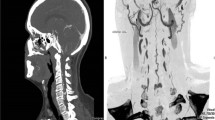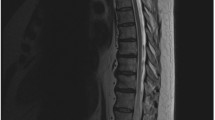Abstract
We report two cases of acute spinal cord compression in children with low-flow spinal epidural arteriovenous fistulas (SEAVFs) and discuss the clinical presentation and management of these vascular anomalies. While most low-flow SEAVFs without radiculomedullary drainage are benign lesions typically diagnosed incidentally, we suggest that asymptomatic lesions may warrant aggressive management in specific circumstances, including lesions diagnosed at an early age or in patients under anticoagulation therapy. Our observations also emphasize that patients with a “spontaneous” epidural hemorrhage should undergo dedicated preoperative or postoperative vascular imaging to identify a possible underlying vascular anomaly.


Similar content being viewed by others
References
Chuang NA, Shroff MM, Willinsky RA et al (2003) Slow-flow spinal epidural AVF with venous ectasias: two pediatric case reports. Am J Neuroradiol 24:1901–1905
Aminoff MJ, Logue V (1974) Clinical features of spinal vascular malformations. Brain 97:197–210
Merland J, Riche MC, Chiras J (1980) Les fistules artério-veineuses intra-canalaires, extra-médullaires à drainage veineux médullaire [Intraspinal extramedullary arteriovenous fistulae draining into the medullary veins.]. J Neuroradiol 7:271–320
Emery D, Cochrane D (1988) Spontaneous remission of paralysis due to spinal extradural hematoma: case report. Neurosurgery 23:762–764
Muhonen MG, Piper JG, Moore SA, Menezes AH (1995) Cervical epidural hematoma secondary to an extradural vascular malformation in an infant: case report. Neurosurgery 36:585–588
Clarke DB, Bertrand G, Tampieri D (1992) Spontaneous spinal epidural hematoma causing paraplegia: resolution and recovery without surgical decompression. Neurosurgery 30:108–110
Sharma RR, Selmi F, Cast IP, O’Brien C (1994) Spinal extradural arteriovenous malformation presenting with recurrent hemorrhage and intermittent paraplegia: case report and review of the literature. Surg Neurol 42:26–31. https://doi.org/10.1016/0090-3019(94)90246-1
Panciani PP, Fontanella M, Crobeddu E et al (2010) Spontaneous occlusion of a spinal arteriovenous malformation: is treatment always necessary?: case report. J Neurosurg Spine 12:397–401. https://doi.org/10.3171/2009.10.SPINE09421
Kang J, Gregg L, Gailloud P (2017) Spontaneous resolution of low-flow spinal arteriovenous fistulas. Neuroradiology 59:1003–1012. https://doi.org/10.1007/s00234-017-1888-x
Dziedzic T, Kunert P, Krych P, Marchel A (2015) Management and neurological outcome of spontaneous spinal epidural hematoma. J Clin Neurosci 22:726–729. https://doi.org/10.1016/j.jocn.2014.11.010
Author information
Authors and Affiliations
Contributions
Rigamonti A — Conceptualization, original draft preparation, images preparation. Gailloud P — Conceptualization, review and editing, supervision.
Corresponding author
Ethics declarations
Ethics approval and consent to participate
Case reports of three patients or fewer are not subject to IRB approval at the authors’ institution. Informed consent was obtained from patients and families for the reported clinical procedures performed as routine clinical studies and accessed retrospectively for preparing this report.
Conflict of interest
P. Gailloud is a paid consultant for Cerenovus
Additional information
Publisher's Note
Springer Nature remains neutral with regard to jurisdictional claims in published maps and institutional affiliations.
Rights and permissions
Springer Nature or its licensor (e.g. a society or other partner) holds exclusive rights to this article under a publishing agreement with the author(s) or other rightsholder(s); author self-archiving of the accepted manuscript version of this article is solely governed by the terms of such publishing agreement and applicable law.
About this article
Cite this article
Rigamonti, A., Gailloud, P. Two pediatric observations of spinal extradural arteriovenous fistulas presenting with epidural hemorrhages and cord compression. Childs Nerv Syst 40, 597–601 (2024). https://doi.org/10.1007/s00381-023-06193-8
Received:
Accepted:
Published:
Issue Date:
DOI: https://doi.org/10.1007/s00381-023-06193-8




